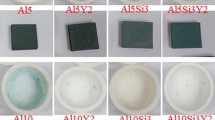Abstract
Five ternary additions, Cr, Ti, Mn, V, and Al were studied at equi-atomicpercent levels (17 a/o) for their effect on the sulfidation behavior of Ni-19a/o Mo (28–30 w/o) over the range of 600–800°C in 0.01 atm S2. Al was by far the most effective addition. A linear decrease in log kp vs. Al content was observed up to 7.5w/o Al, beyond which no further change was observed. All alloys followed the parabolic rate law. Arrhenius plots gave activation energies of 36.9–41.2 Kcal/mol for alloys containing Ti, Cr, Mn, and V, whereas the activation energies for Al-containing alloys were 47.2 Kcal/mol, indicating that a different diffusion process was involved. Complex scales were formed on all alloys, consisting of an outer layer of Nis1+x and complex inner layers which depended upon alloy composition. Two alloys, those with Cr and Mn, formed intermediate layers of Cr2S3 and MnS, respectively, but these layers had little effect on the kinetics. MoS2 was a constituent of the inner scales except for the alloys with Al. A ternary sulfide, Al0.55Mo2S4 and Al2S3 were observed. The presence of the mixed sulfide was always associated with the low sulfidation rates. The formation of MoS2 on alloys results in a different, less-protective behavior than for MoS2 formed on pure Mo. This effect is due to the intercalation of Ni into MoS2 in octahedral positions between the weakly bonded layers of covalently bonded sheets of trigonal prisms. The size of Al+3 is too small to be intercalated, and thus MoS2 is destabilized by Al.
Similar content being viewed by others
References
S. Mrowec and K. Przybylski,High-Temperature Materials and Processes 6, 1 (1984).
S. Mrowec and K. Przybylski,Oxid. Met. 23, 107 (1985).
M. F. Chen, D. L. Douglass, and F. Gesmundo,Oxid. Met. 31, 237 (1989).
M. F. Chen and D. L. Douglass,Oxid. Met. 32, 187 (1989).
H. Rau,J. Phy. Chem. Solids 41, 765 (1980).
J. Mering and A. Levialdi,C.R. Acad. Sci. 213, 798 (1941).
J. C. Wildervanck and F. Jellinek,Z. Anorg. Alleg. Chem. 329, 309 (1964).
A. J. C. Wilson,Proc. Roy. Soc, Ser. A 180, 277 (1942).
B. E. Warren,Phys. Rev. 59, 693 (1941).
B. E. Warren,X-ray Diffraction (Addison-Wesley Publ. Co., 1969), pp. 298.
C. Wagner,Corr. Sci. 5, 751 (1965).
K. N. Strafford, Conference on Degradation of High-Temperature Materials, 5/1 (1980).
S. R. Shatynski,Oxid. Met. 11, 307 (1977).
R. C. Weast, ed.,Handbook of Physics and Chemistry, 66th ed., (CRC Press Inc., 1985).
G. Kullerud,Fortschr. Mineral,41, 221 (1964).
H. Schmalzried and A. Navrotsky, ‘Festkörperthermodynamik (Verlag Chemie, Weinheim, 1975) pp. 157.
J. Phys. Chem. Ref. Data 14, 165 (1985), Suppl. 1.
J. Flahaut,Ann. chim. 7, 632 (1952).
D. J. Young, W. W. Smeltzer and J. S. Kirkaldy,Met. Trans 6A, 1205 (1975).
D. J. Young, W. W. Smeltzer, and J. S. Kirkaldy,J. Electrochem. Soc. 120, 1221 (1973).
D. L. Douglass and M. Z. Wu,Oxid Met. 22, 45 (1984).
B. Gleeson, D. L. Douglass, and F. Gesmundo,Oxid. Met. 31, 209 (1989).
W. A. West and A. W. C. Menzies,J. Phys. Chem. 33, 1880 (1929).
D. B. Miracle, K. A. Lark, V. Srinivasan, and H. A. Lipsit,Met. Trans. 15A, 481 (1984).
J. M. Vandenberg and D. Brasen,J. Solid State Chem. 14, 203 (1975).
J. A. Wilson and A. D. Yoffe,Advances in Physics 18, 193 (1969).
B. S. Lee and R. A. Rapp,J. Electrochem. Soc. 131, 2998 (1984).
M. Kamaratos and C. Papageorgopoulos,Sol. St. Comm. 61, 567 (1987).
A. L. Farragher and P. Cossee,Catalysis Proc. Int. Congr. 5th 2, 1301 (1972).
D. Brasen, J. M. Vandenberg, M. Robbins and R. C. Sherwood,J. Solid State Chem. 13, 298 (1975).
Author information
Authors and Affiliations
Rights and permissions
About this article
Cite this article
Chen, M.F., Douglass, D.L. Effect of some ternary additions on the sulfidation of Ni-Mo alloys. Oxid Met 33, 103–133 (1990). https://doi.org/10.1007/BF00665672
Received:
Revised:
Issue Date:
DOI: https://doi.org/10.1007/BF00665672




